
I have known Richard Parry and followed his career for over 15 years. We have connected in our different roles and organisations over this time due to a joint enthusiasm for a vast swathe of artists.
We share a love of performance, the absurd and working with interdisciplinary artists who collaborate and continually push the edges of their practice. Artists I have worked with that Richard has included in his curatorial projects have included Bedwyr Williams, Mai-Thu Perret and Paulina Olowska.

I like to work with artists when I feel that the opportunity might enable a way for them to push their practice, or fulfil something that they might have not been able to realise yet. I hope that I can provide a chance to bounce off ideas and to assist in helping to shape the show if that’s wanted or necessary.''
Please note this interview was first published on the Artist Mentor website during 2020.
I have visited many of his exhibitions in different organisations and locations over the years and know that I will continue to be curious about his curatorial and directorial endeavours. I am a fan of the lush weird environments he supports artists conjuring.
His gentle demeanour belies a dogged determination to get the job done and he goes to extraordinary lengths to make strange things happen in unusual ways. He keeps taking himself out of his comfort zone to learn, to develop and create new opportunities for artists.
Richard Parry is Director of Glasgow International, Scotland’s biennial festival of contemporary art. Prior to this he was Curator-Director of the Grundy Art Gallery Blackpool where he curated and organised upwards of 30 exhibitions, including solo exhibitions by Mark Leckey, Heather Phillipson, Matt Stokes and Jennet Thomas, as well as the group exhibitions Sensory Systems and Neon: The Charged Line.
Previously to joining the Grundy, Parry was Assistant Curator at the Hayward Gallery, where he organised exhibitions including Psycho Buildings, The New Décor, Walking in my Mind and the ambitious project Wide Open School, where the gallery was turned into a giant ‘school’ involving 100 artists from around the world. Prior to the Hayward he worked as Exhibitions and Collections Assistant at the Visual Arts Department of the British Council.
Parry is also a critic and writer and has written for art magazines including Frieze, Art Review and Modern Painters, amongst others.
What are you doing, reading, watching or listening to now, that is helping you to stay positive?
I’ve been staying in a new flat since just before lockdown. It’s a tenement in Glasgow and at the start of this the garden was completely overgrown, with sprawling weeds and the like. An elderly neighbour moved in around the same time as me (with a cat called Prozac) and started to do a bit of clearing. It wasn’t long before I was joining in – such as social distancing would allow – and then another neighbour as well. It’s really encouraged a sense of community in the building. I’ve also been listening to podcasts including one that a couple of colleagues/friends (Jenn Ellis and Cliff Lauson) started called Between Two Curators. Mubi has been important. I miss the cinema and this has been something of a lifeline on that front. I’ve been a subscriber for years but it’s never been as important. For much of lockdown I have been tuning into a radio station called ‘Radio Caroline’ that the writer and critic Jonathan P. Watts ran daily during lockdown via the digital platform Twitch, broadcast from a front room in Norwich.
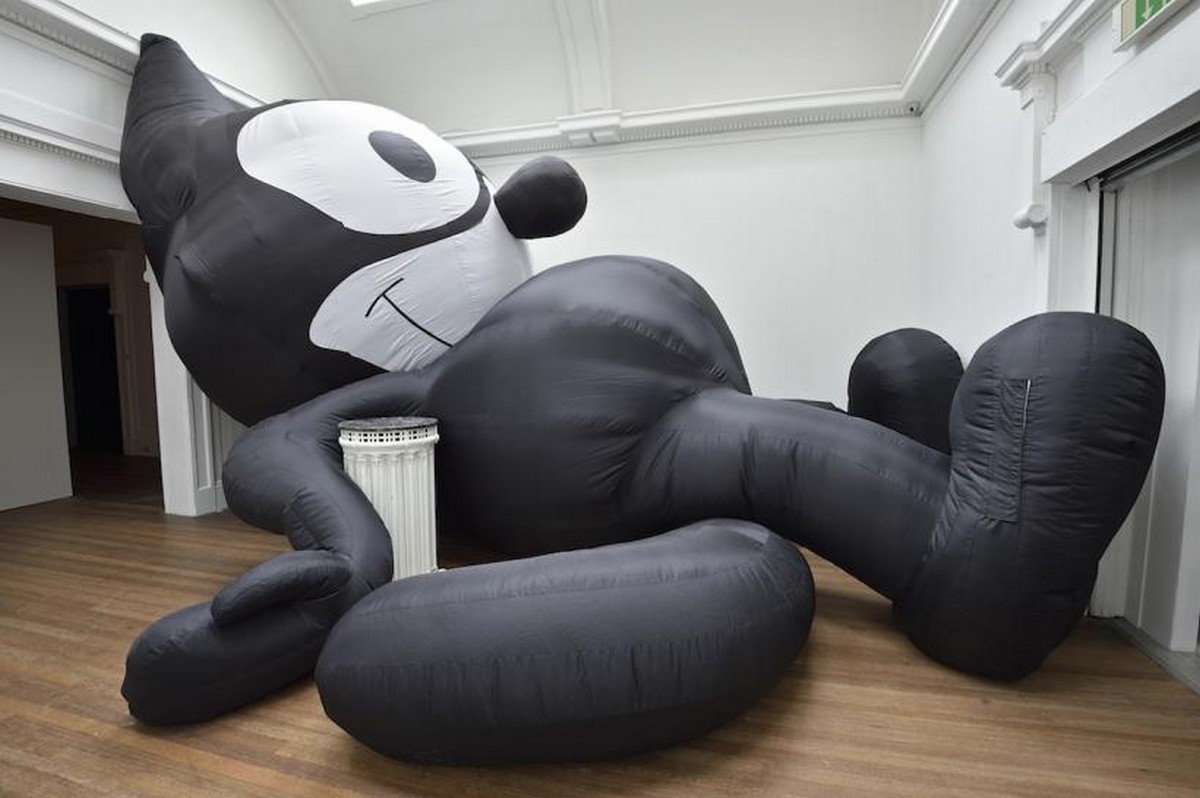
Mark Leckey, This Kolossal Kat, That Massive MOG, 2016, Installation view: Grundy Art Gallery, Blackpool, Courtesy the artist and Cabinet, London
What are your core values and drivers that you bring to your curatorial work? What do you care about?
I hope that I bring an approachability to my curating. I think that the way I work tends to be quite collaborative and undertaken through partnership. I want to create a space in which an artist can develop new work and in that way is an empowering process, but also one in which the context and audience are there in the picture. For me one of the wonderful things about working with artists is that you have an opportunity to really engage with different voices and approaches, and to be able to share this with others. When I was in Blackpool I thought a lot about the civic role of art galleries and art in general and I’m very tied to the – probably quite unfashionable – notion of undertaking a public service. I think that if anyone had any doubts about just what an essential public role art and art galleries, museums, festivals etc. play then the advent of Covid-19 and lockdown have really cast these aside.
At the Grundy I also became really aware of, and passionate about, a broader ecology – which might be quite a small ecology – and how artist-run spaces, perhaps especially in less ‘prominent’ towns and cities or can be doing things that are really vital. Being out of the spotlight, but in a supportive environment in that way can encourage genuine risks to be taken. I think back to the incredible programme that Supercollider was doing in Blackpool, with early solo shows for artists like Mathew Parkin (2012), Ima-Abasi Okon (2014), as well as exhibiting the likes of Jamie Crewe and Sean Edwards in group shows around that time. It’s clear the work that such a space can do – often largely unnoticed – in both seeking out and providing artists with shows at key points in their careers. A space like Supercollider would not have existed without the Grundy, as much as anything because the town’s gallery provided a job to the curator who ran it, Tom Ireland. It’s a reminder that at the end of the day, everything is connected, and that every show is important.
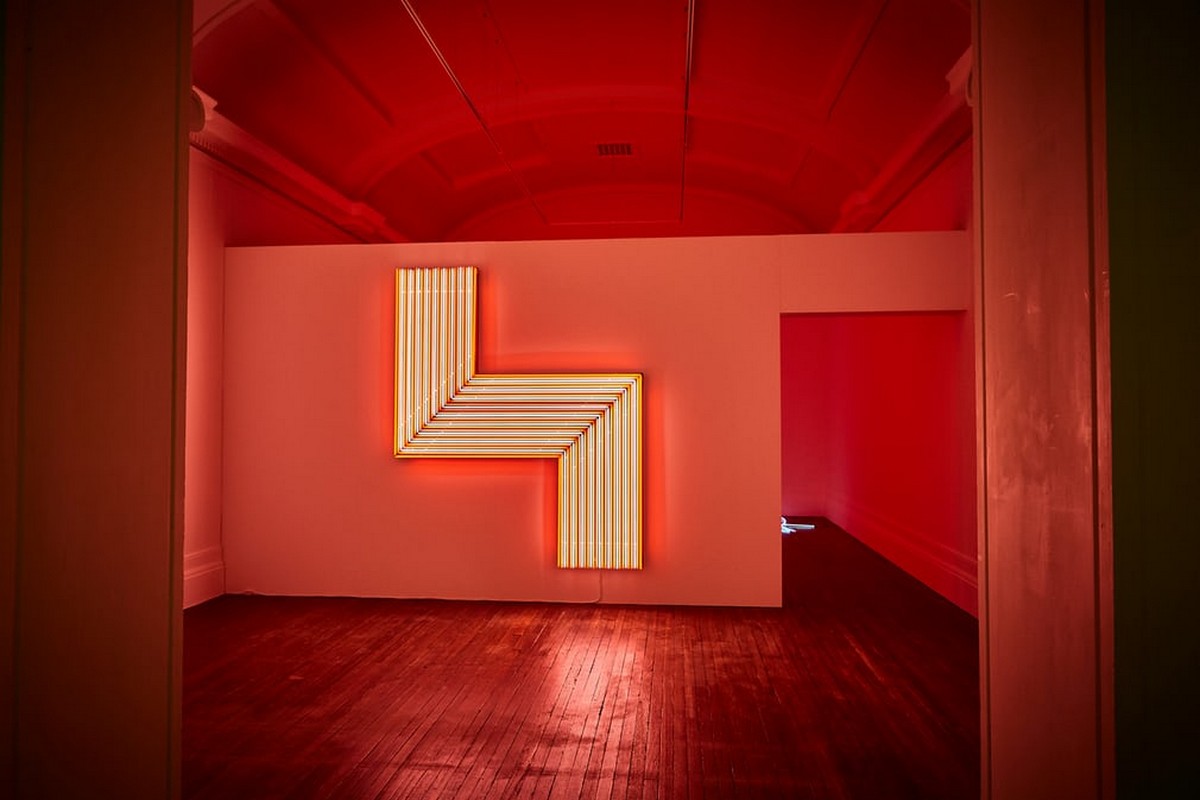
Bertrand Lavier, Telluride II, 2005, Neon: The Charged Line, Grundy Art Gallery, Blackpool, 2016, Installation view, Courtesy the artist and Kewenig
How do you develop your curatorial ideas? How do you test or scope your ideas?
Fundamentally, my approach is multi-disciplinary. I did a Masters at the London Consortium, which no longer exists now but at the time was an incredible initiative involving a collaboration between the Tate, the Architectural Association, the ICA and Birkbeck College. The approach of this combined Masters and PhD programme was to bring together students from difference disciplines (I had studied history as an undergraduate) and explore topics from a myriad of different perspectives. If we look at the Glasgow International festival that was supposed to happen this year, and which is now postponed until next year, the theme for this was ‘attention’. I would say the genesis of how I would be working with a theme such as that – both open and complex but also offering a frame – started at the Consortium. Other important markers in the development of this theme were working with Brian Dillon, Lauren Wright and Roger Malbert on the exhibition ‘Curiosity’ for Hayward Touring at Turner Contemporary in 2013. Brian would often talk about attention. The point at which this theme crystallised was through a conversation with the writer and critic Orit Gat back in summer 2018, in which for me this sense that it could be a method, or approach, as much as a theme, became clear. Attention is in some respects a challenge – a daunting theme as a curator. I get the sense that many of us who practice art or curating are in some measure perfectionists, and so paying attention to things is at the heart of it, but inevitably there will always be blind spots. It is perhaps a paradox and double bind that runs through everything.
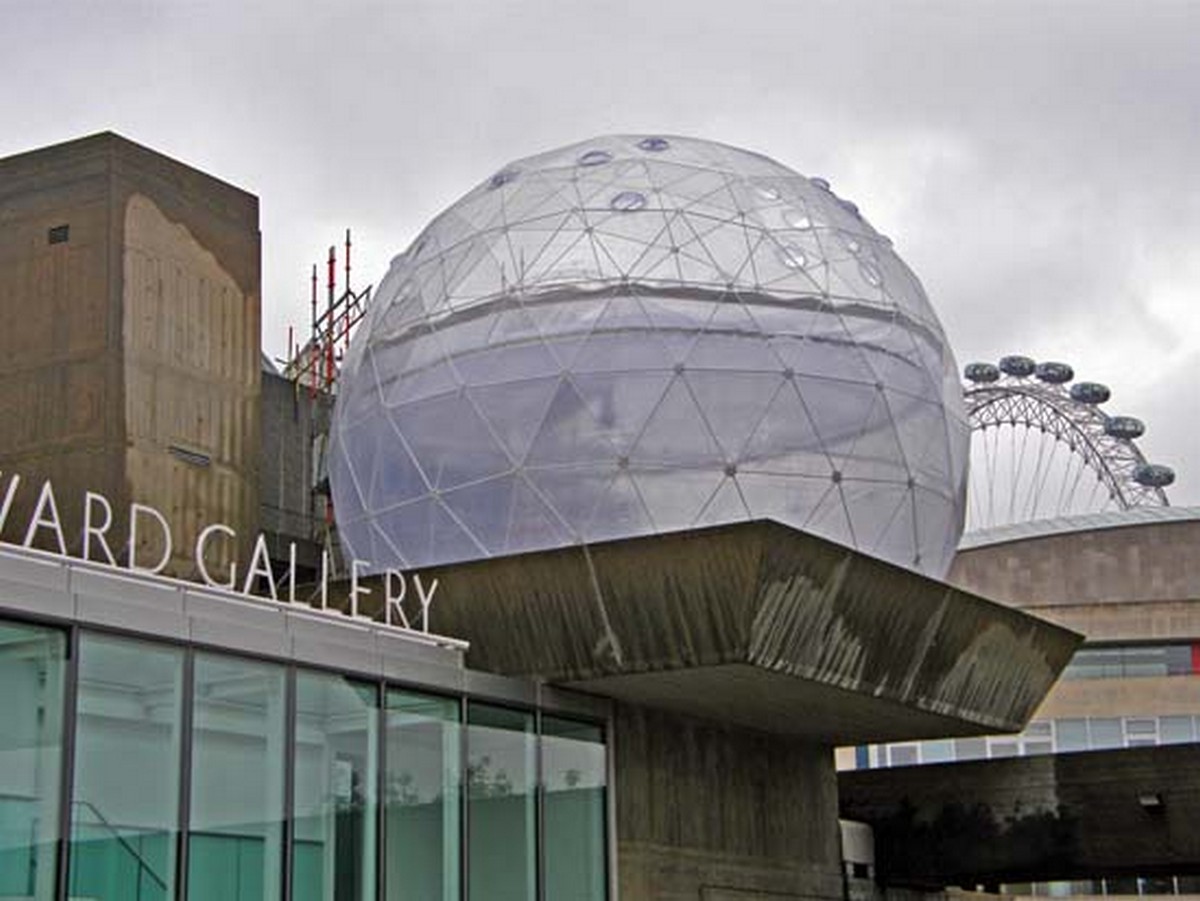
Tomás Saraceno, Observatory, Air-Port-City, 2008, Hayward Gallery, Southbank Centre, London, Installation view,Courtesy the artist and Tanya Bonakdar Gallery, New York
How do you discover artists and what makes you finally decide you want to work with an artist?
Something that I’ve been thinking about recently, which is very connected to attention, is the importance of looking – of going and seeing shows and then really looking at the work. Also of visiting and meeting artists, which I always feel I could do more of, but is vital. There are always exhibitions you will inevitably miss of course for a whole host of reasons, but I’ve become more and more aware recently about how shows I’ve seen – in some cases many years ago – have stayed with me on many occasions. Specific works that bury away in your memory or unconscious even and then it’s only later their importance becomes apparent.
So much does happen now online, in particular through Instagram so that is also another important way of finding out about exhibitions and seeing a representation of an artist’s work. The decision is not necessarily whether to work with an artist (although that’s clearly important) but can often be more about what feels like the right moment and context. Some of the artists I find most connection with and have known the longest I have not yet worked with in an exhibition, because the right opportunity hasn’t seemed to present itself or it hasn’t worked out for one reason or another. At other times you discover an artist’s work and then an opportunity comes that feels absolutely right to work with them on something right away. That could be to do with, for instance, the exhibition space itself, it could be about how it resonates with key debates, concerns or questions at a certain moment, how the work exists in relation to other work or in relation to an entire programme, or where an exhibition is taking place geographically.
How do you gauge which artists and artworks will be interesting to audiences?
I think this very much links with the previous question as I’m always trying to think about audiences when I am programming work. In Blackpool, we were committed to generating a programme which we hoped would resonate with the context of the town and that audiences would hopefully be able to connect with. In many respects the audience there was very a-typical to what you might imagine a contemporary art audience to be. Blackpool is one of, if not the most, deprived town in England and Wales and where the gallery is situation is right in the middle of the most deprived ward. Around a third of our audience lived within a mile radius and were unlikely to have, for instance, have had much in the way of formal art training and in many cases were probably living in fairly desperate circumstances. You were aware that for some people, the gallery was quite simply a helpful place to get warm, or somewhere you could go and chat with the person at the front desk, or somewhere that quite simply wasn’t home or school, both of which might be sites of pain or trauma. That social function is often completely unrecognised. One of the ways that we looked to find ‘ways in’ was to work with artists whose practice somehow resonated with popular culture – something that the town is famous for. So, in this respect, we might work with Simeon Barclay or Mark Leckey, but equally we might look at other elements of Blackpool’s past such as its history of staging party political conferences, in the case of Jennet Thomas. The gallery office was right next to the welcome desk and so you basically got a sense of nearly everyone who came into the gallery and their responses to the shows. I remember an elderly couple watching the entirety of an hour long Mark Leckey performance lecture video – they were totally absorbed. It’s hard to predict or second-guess what’s going to connect, in many respects at the end of the day you simply have to go with what feels right, but it takes a lot of work, and a lot of listening, to get to that point.
Curating for a festival is totally different to curating for a venue and the audiences can be very different. You aren’t getting to know audiences throughout the seasonal ebb and flow of the year, you are a moment of crescendo and congregation, of stimulus and a site of dialogue, exchanging of ideas and intermingling of circles and networks, as well as a site of showcase. It is far more focussed, far more visible and as a result there is also far more attention on all aspects – everything has to be on point. So as a curator you are doing a lot of listening and looking, at once to artists, cultural commentators, critics and other curators. In the case of GI, it is also very dispersed, with a huge number of voices, curators and artists involved, so it’s never just one person or set of eyes. The programme needs to speak to and nourish those who live and breathe contemporary art, but you also hope that what you’re doing resonates far wider than a smaller group of highly engaged specialists. My experience is that if the art really has something to say then audiences will pick up on that.
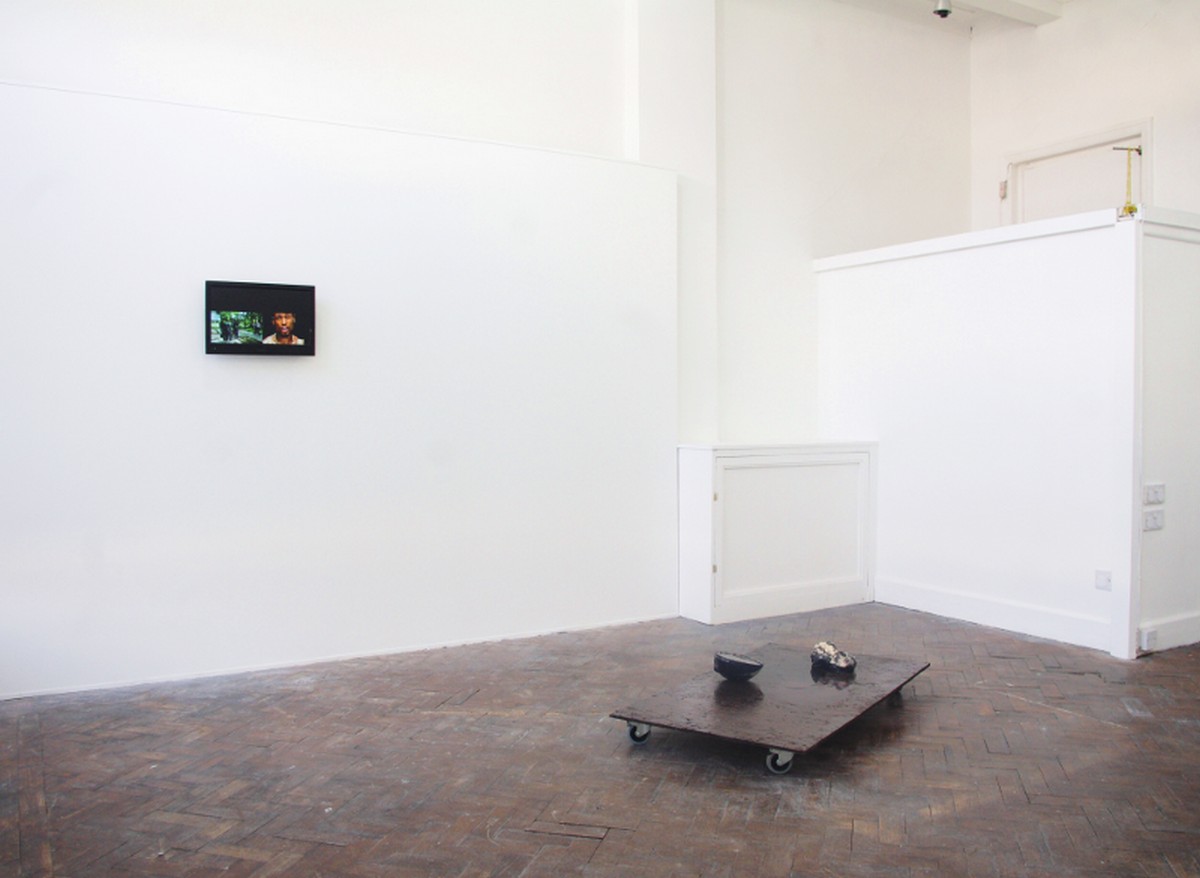
Ima-Abasi Okon, The Fountains Are Decorative and Are Not Water Play Areas, 2014, Installation view, Supercollider Contemporary Arts Project, Blackpool, UK
Courtesy the artist. Exhibition curated by Tom Ireland
What do you offer or provide artists in the curatorial relationship?
As a curator you always hope that you are giving something more than simply an opportunity – although clearly that is central. I find it important to remember that you are in an amazing and fortunate position to be able to give someone a platform and that’s a very serious responsibility. I like to work with artists when I feel that the opportunity might enable a way for them to push their practice, or fulfil something that they might have not been able to realise yet. I hope that I can provide a chance to bounce off ideas and to assist in helping to shape the show if that’s wanted or necessary. It can really vary massively and this can be linked to the point at which an artist is at in their career, but it could also be about simply how they work. Some artists are really keen to have your input, and for others they have a very definite sense of what they want to do and the role becomes more facilitating. I guess it’s part of the role of curating to judge when and how suggestions at certain moments might open up new territory or assist the artist in enabling new ways of approaching a certain space or the narrative thread of a show. I think that what one can offer is also sometimes totally unrelated to an exhibition, for instance there might be people, texts or other materials that you can help with or suggest.
Can you describe what you ideally want to achieve when curating an exhibition?
Fundamentally as a curator I would see myself as someone who connects artists with audiences and so it is my goal to facilitate this in such a way that it is enriching and resonant for both. The magical moments are when you feel that you have been involved in something that has really gone beyond the parameters of expectations, such as when we did the neon exhibition in Blackpool, which was the first time that contemporary art had garnered substantial national media attention in a positive way in the town, and not simply written off as some kind of opaque elitist joke, which is how a lot of people seemed to characterise it. I got the genuine sense that it was a turning point for how decision makers in the town (e.g. funders, politicians) and many members of public saw how contemporary art could be not just relevant but also something they could connect with and be proud of in relation to the place they lived.
Another way I always thought about this was that the power or importance of an exhibition would not necessarily be felt for years to come – the ultimate goal would have been for someone who was growing up in Blackpool to have come to gallery, without knowing what to expect, and for them to have connected in some way with the work on show and to have discovered something in them that they had not felt before. It would be quite an achievement if this experience would then have led them to have pursued art or some other creative path, which they might not previously have even imagined let alone felt was something for them, and that this experience had been something of a turning point in their life. I hope that this might have happened although I’ll probably never know.
On the flipside of this, sometimes the most rewarding projects are when you see the impact that it has had for an artist. Perhaps Tai Shani in the 2018 Glasgow International is a good, or at least well known, example here. This is a project that was originally set for Blackpool in a joint commission with the Tetley in Leeds, but taking this to Glasgow and having the opportunity to develop it in an incredible theatre space like Tramway, with the amazing technical team there alongside the team at GI, the performers etc., really gave it something beyond. Tai is an artist who has been making incredible work for years – perhaps a little more under the radar until that point – and this opportunity I think really showed to a much wider audience what she is capable of and it was very energising to see that.
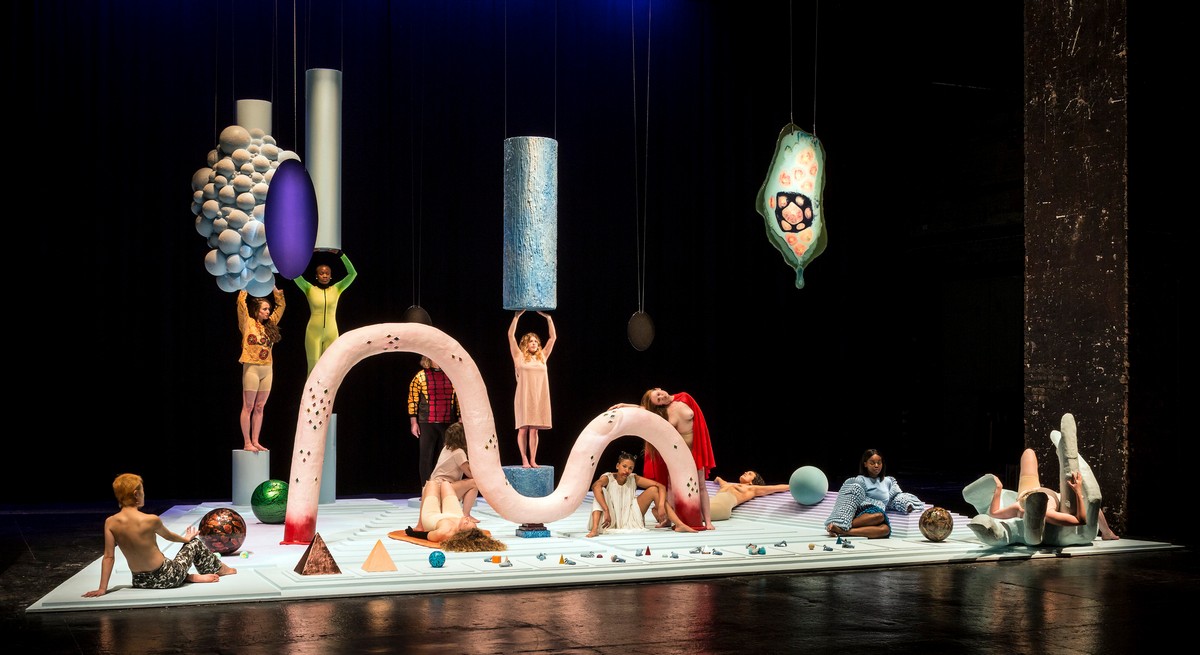
Tai Shani, DC: Semiramis, Installation view, Tramway, Glasgow International 2018. © Keith Hunter. Courtesy the artist
Can you describe one of your most rewarding relationships with an artist – what factors made it enjoyable?
I would say that perhaps the most rewarding relationships with artists are those that last and where there is a genuine sense of exchange, dialogue and in many respects mutual learning – one where the conversation keeps going. It’s also very rewarding when an exhibition has a big impact for an artist, or has perhaps opened up some new questions or opportunities. Whilst Tai is one example, there are other less appreciated examples that were very rewarding for me. In Blackpool one of the final shows I worked on was with Rob Crosse, now living in Berlin. Whilst the centrepiece of the show was a film commission undertaken with Film and Video Umbrella, we also invited Rob to take on the entire galleries in a solo show. The galleries are specious – around the same size as the Hayward’s upstairs spaces when added together. This encouraged the artist to show photography work, create a towel sculpture/partition, and really take on the space as a whole. Although seen by far fewer people I would also regard that as enormously rewarding experience.
What risks have you taken in curating that perhaps did not go so well but you learnt the most from?
I would say that risk is at the heart of producing both artwork and exhibitions. If you’re not taking a risk then honestly, what’s the point? I don’t want to go into an exhibition ‘knowing the answer’. In some respects there was a point at which I realised that a lot of what I was doing e.g. in Blackpool was an accumulation of trial and error. How else do you learn? You try something out, it might work, it might fail and in many respects the times when it fails are the times when you’re really learning. Sometimes this risk can be difficult for other reasons, as in the case of Jennet Thomas’s exhibition at the Grundy, which was effectively postponed (at the time it was described as censorship) due to complaints from politicians that its content was propaganda and not artwork. This took over a year of hard work, conversations and struggle to enable the show to proceed, helped by figures such as Guardian cartoonist Martin Rowson (upon whose work the show was a point of inspiration) coming to the town in support of it. It also helped to have had an artist in Jennet who was so committed to the project and whom had the reserves of patience to work with us towards a new date.
Another example that I think is important here is the online programme in lieu of GI this year. This is something that came about after the big shock and disappointment of the festival not going ahead. Myself and the curatorial team (Poi Marr and Nora Almes) had absolutely no time to think about it and so it was very intuitive, although of course we had been thinking about and working on the programme for many months so it would be wrong to say it came out of nowhere. We were lucky to have a wonderful digital consultant (Leah Silverlock) who helped us to come up with the format of taking over the website homepage, amongst other things. The artists all responded in an extraordinary way and I still can’t quite believe what they were able to pull off at such short notice and with so much going on in everyone’s lives, it really was incredible.
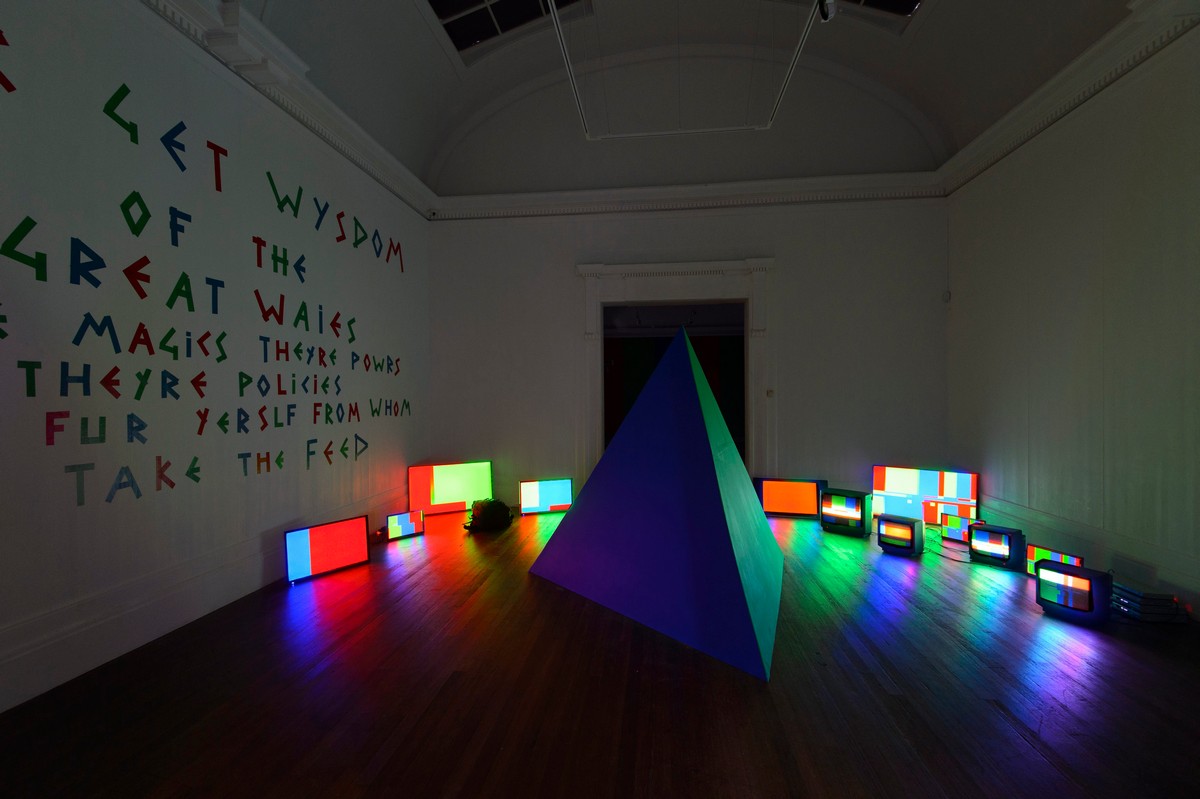
Jennet Thomas,The Unspeakable Freedom Device, 2014, Installation view: Grundy Art Gallery, Courtesy the artist
What is one of your personal favourite exhibitions or events you have curated and why?
Usually, I would have to say that the exhibition you are working on currently is always the favourite – or most important – at any given moment. At the moment, with the postponement, it’s easy to feel in a kind of strange limbo. That said, I’ve been doing a fair amount of reflection and looking back recently and there are certain shows that stand out for different reasons. These are not always shows I’ve curated – such as Psycho Buildings (2008) at the Hayward, curated by Ralph Rugoff. I came on board as Assistant Curator with only a few months to go and with HUGE amounts still to do. It was conceived in a pre-financial crash environment and feels like a kind of end-of-an-era show now, in terms of the budgets and the scale of the works. The ambition was phenomenal and it was exhilarating. Whilst working on large shows in the main Hayward Gallery I also curated smaller more under-the-radar shows around the Southbank, which allowed much more scope for personal development as a curator. Favourites here were Olivier Castel who has a truly expansive imagination and also Sara MacKillop in the Saison Poetry Library. In Blackpool I felt phenomenally invested in every show, but looking back now I have a particular fondness for the first one I did, simply called ‘Collections Show’ in which we invited members of the public to show their collections of things. It ended up being a kind of portrait of a collective unconscious of a place, in a fascinating and quite touching way. Heather Phillipson was another highlight – a show which came to us from Baltic and was technically very complex, including craning a car inside the building on its side. Some of Heather’s work is now in the Grundy Collection and what was amazing was coming back recently having artists living in the area talking to me about that show and how important it was for them.
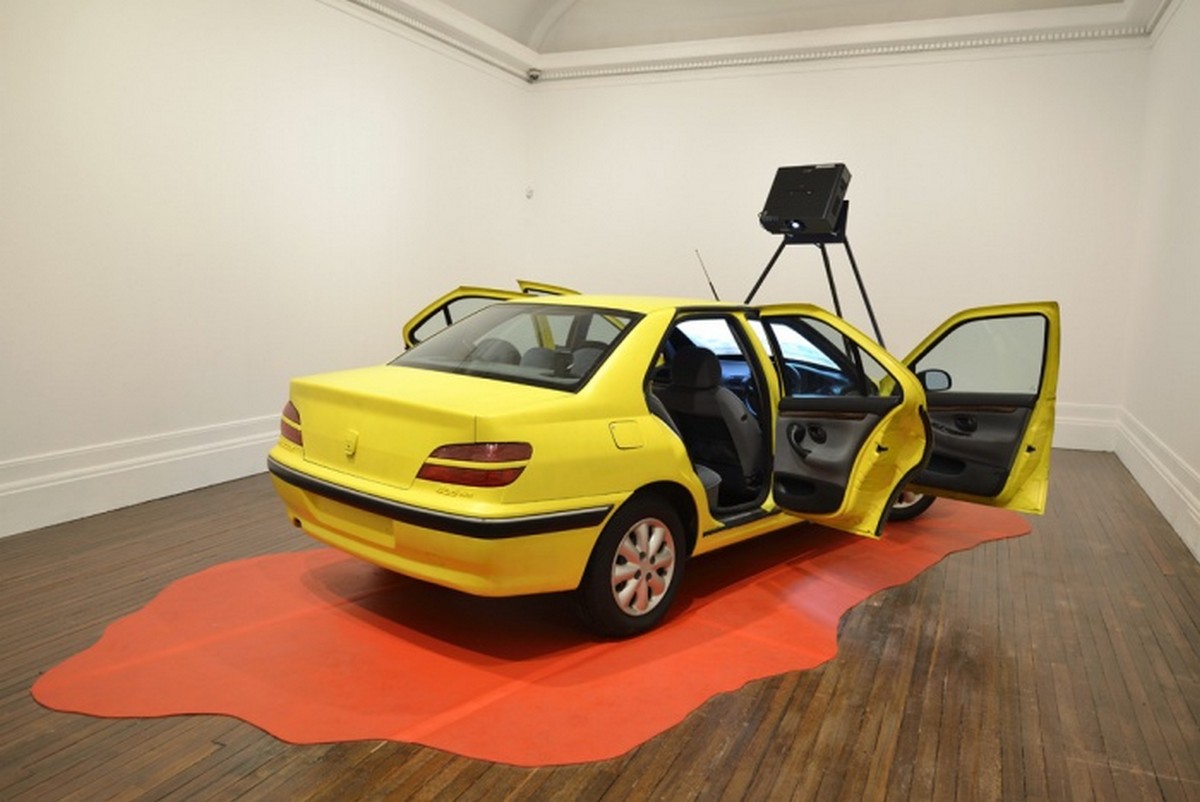
Heather Phillipson, A Is to D What E Is to H, 2011–13, Installation view, yes, surprising is existence in the post-vegetal cosmorama –, 2013, Grundy Art Gallery, Courtesy the artist
What would you hope that people experience and learn from seeing one of your exhibitions or events?
For me, one of the things that art does, is that it has the power to show you something – communicated in a way that is beyond and outside of text – to show you something important that you didn’t realise that you needed to know. Or perhaps that you always knew but had never had brought to the surface. I hope I’ve been involved in exhibitions where this has happened.
Do you help fundraise for the show you curate & if so how?
I would say 80%+ of what I spend my time doing is fundraising – it’s goes without saying that it’s in way the main part of what I do. I’ve never worked in a team where there is a development role so I’ve always needed to do all or a significant proportion of the fundraising or managing relationships with funders. This is a mixture of working with state funders such as local authorities, government departments, Arts Council England or Creative Scotland, or trusts and foundations, or sometimes with private donors. A new thing for me coming to Glasgow was the editions, which have the potentially to be hugely important for fundraising. We have been trying to find ways of bringing in income through taking part in art fairs – all of which feels like a distant memory right now!
What emerging artists are you excited by right now and why?
I’m never very comfortable with this term emerging – like someone’s coming out of a flowerpot or something. But thinking about early career artists I would say that Glasgow is an incredibly exciting place in this regard. This year’s programme would have seen (and will see next year) exhibitions that I was really looking forward to by the likes of Sekai Machache, Andrew Sim, Liv Fontaine, Andrew Black and Aman Sandhu to name a handful. Someone was describing to me that they felt the GI programme carried a sense of urgency and I think this is latent in these artists’ work, albeit in very different ways. I think that another artist at a very interesting point in their career is Urara Tsuchiya. Urara has been working away in Glasgow for years and is fairly established here but is only just now coming to the consciousness of a wider public outside of the city.
What helpful resources would you recommend to artists?
I hope I have a few suggestions that I can offer but in all honesty it is usually artists who are telling me about amazing things they’ve come across. I like to be responsive to each artist that I’m working with – what can be enjoyable is when you establish a connection with an artist’s practice, and then can tune suggestions to that specifically. Going back to the first question I’ve personally been really enjoying the daily updates from the ICA as nourishment through lockdown.
Do you have any advice for artists working with curators?
Please be patient with us! Following on from the point about fundraising, the tricky thing is that there is often far less time than you would like for the actual job of curating, e.g. for researching and then working with an artist and giving them your attention. This is particularly so when (as in my past two roles) I have both curated exhibitions and been responsible for the organisation as a whole. This can lead to a relative paucity of both time and also mental space, as you’re juggling and working through so many decisions at any given time. It’s a tricky thing as institutions can seem big and grand, with snazzy graphics and the like, but the reality often is that it’s a handful of people there holding the whole thing together and juggling a million things, most of which are unseen. I think that it’s important that for both sides undertaking a show is a big deal – nothing is going to be entered into lightly without a lot of forethought. I would also say that it means a lot to a curator when the dialogue and exchange doesn’t finish when the exhibition does.
Follow Richard on Instagram and Twitter @rhmparry @Gifestival https://glasgowinternational.org/